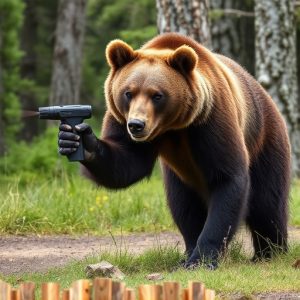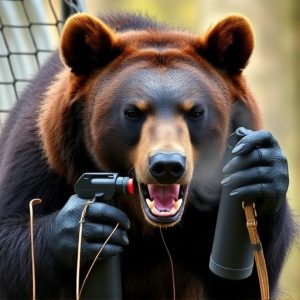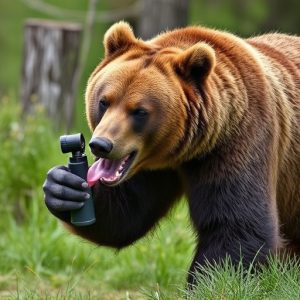Bear Repellent Spray: Effectiveness, Safety, and Longevity Explained
Understanding bear behavior is crucial for hikers, especially regarding black bears' increased…….
Understanding bear behavior is crucial for hikers, especially regarding black bears' increased aggression in spring and summer. Bear repellent spray, primarily containing capsaicin, disrupts a bear's olfactory and respiratory systems, offering temporary blindness and disorientation (lasting from minutes to an hour). Effectiveness varies based on weather, concentration, and bear sensitivity. Proper usage techniques and understanding the duration of pepper spray contamination are vital for safe hiking in bear country. While natural repellents exist, traditional pepper spray remains the superior choice for consistent protection due to its extended sensory disruption.
“Bears in hiking trails pose a significant safety concern, making bear repellent spray an indispensable tool for outdoor enthusiasts. This comprehensive guide explores the effectiveness of pepper spray in deterring bears, delving into its science and longevity. We’ll navigate the ‘When and Where’ of its use, dissect the mechanism behind its power, and discuss safety protocols. Additionally, alternative methods are compared to offer a holistic perspective on bear safety. Prepare to embark on a journey through the essentials of staying safe in bear country.”
- Understanding Bear Behavior: When and Where Spray is Necessary
- The Science Behind Pepper Spray: How It Works Against Bears
- How Long Does Pepper Spray Remain Effective?
- Safety Considerations: Proper Use and Storage of Bear Repellent Spray
- Alternative Methods and Their Efficacy Compared to Pepper Spray
Understanding Bear Behavior: When and Where Spray is Necessary
Understanding bear behavior is key to determining when and where bear repellent spray is a necessity for hikers. Bears are generally shy animals that prefer to avoid human interaction. They use their keen sense of smell to detect potential threats, and they often retreat at the first sign of danger. However, during certain times of the year, especially in spring and summer when cubs are born, bears become more aggressive in defending their territory and offspring. This is particularly true for black bears, which tend to be less fearful of humans than grizzly bears.
When hiking in areas known for bear activity, such as forests with abundant food sources or remote backcountry regions, carrying a bear repellent spray becomes essential. The spray should be used when you encounter a bear or even before if the animal shows signs of aggression or curiosity. It’s important to note that bear sprays are not permanent contaminants; how long pepper spray contaminates an area depends on factors like wind direction and weather conditions. Proper usage involves aiming for the bears face and eyes, which can deter them from approaching further.
The Science Behind Pepper Spray: How It Works Against Bears
Bear repellent spray has become a hiking necessity, and understanding the science behind its effectiveness against bears is crucial for any outdoor enthusiast. Pepper spray works by targeting the bear’s sensory system, specifically its olfactory (sense of smell) and respiratory systems. The active ingredient in most bear repellents is capsaicin, the chemical that gives peppers their heat. When sprayed, capsaicin irritates the mucous membranes in a bear’s nose and eyes, causing them to tear up and sneeze, temporarily blinding and disorienting the animal. This disruption creates a critical window of opportunity for hikers to retreat safely.
In terms of how long pepper spray contaminates a bear, studies show that the effects can last from several minutes to as long as an hour. The duration depends on various factors such as the concentration of capsaicin, weather conditions, and the bear’s individual sensitivity. It’s important to remember that while pepper spray is effective in deterring bears, it should be used as a last resort when physical attacks are imminent. Proper precautions, like making noise to alert bears to your presence and avoiding surprising them, are equally vital for safe hiking in bear country.
How Long Does Pepper Spray Remain Effective?
The effectiveness of bear repellent spray, often containing capsaicin or pepper oil, depends on various factors, including weather conditions and the individual bear’s behavior. Typically, a single application can remain potent for several hours, creating a temporary but crucial barrier against unwanted encounters. The duration of its efficacy as a contaminant is equally significant; pepper spray can deter bears for up to 40 minutes, giving hikers valuable time to retreat or avoid potential attacks.
However, it’s important to note that the length of its effectiveness may vary based on how it comes into contact with the bear. Direct spraying onto the animal ensures maximum impact, while indirect application might result in shorter durations. Additionally, factors like wind and rain can significantly reduce the spray’s range and persistence, emphasizing the need for proper usage techniques during hikes in bear-inhabited areas.
Safety Considerations: Proper Use and Storage of Bear Repellent Spray
When hiking in areas known for bear populations, carrying bear repellent spray is a vital safety measure. It’s crucial to understand how to properly use and store this device to ensure maximum effectiveness and minimize risks.
Bear repellent sprays typically contain capsaicin, the active ingredient found in chili peppers, which irritates bears’ eyes, nose, and respiratory system. To maintain its potency, keep the spray sealed when not in use. Store it in a cool, dry place away from direct sunlight or extreme temperatures. Before each hike, check the expiration date and ensure the can is full. During use, aim for the bear’s face and eyes, following the product instructions. Remember, pepper spray doesn’t “contaminate” bears for an extended period; its effect is immediate and temporary, deterring bears from approaching.
Alternative Methods and Their Efficacy Compared to Pepper Spray
While pepper spray is a popular and effective bear repellent, it’s worth exploring alternative methods for those seeking diverse options or wanting to understand their own efficacy. Many natural repellents, such as bear spray (a misting solution containing capsaicin, the active ingredient in chili peppers), can provide protection from bears. However, when comparing these alternatives to conventional pepper spray, there are key differences in effectiveness and duration.
One advantage of traditional pepper spray is its immediate impact. It temporarily blinds and disorients bears through irritation, giving you crucial time to escape. The effects typically last for a few minutes to an hour, depending on the concentration and weather conditions. In contrast, natural repellents like bear spray may take longer to kick in (a few seconds to a minute) and offer less intense disruption, lasting around 30 minutes to an hour. Thus, while natural options are safer for the environment and some users prefer them for ethical reasons, pepper spray remains superior in terms of how long it contaminates the bear’s senses, providing more consistent and immediate protection during hiking and camping trips.
In conclusion, bear repellent spray is a vital tool for hikers navigating areas with known bear populations. Understanding bear behavior, the science behind pepper spray, its duration of effectiveness, safety considerations, and alternative methods are all crucial aspects to ensure its proper and effective use. With the right knowledge, you can make informed decisions in potentially dangerous situations, ensuring your safety while exploring nature’s tapestry. Remember, awareness and preparation are key when venturing into bear country.


